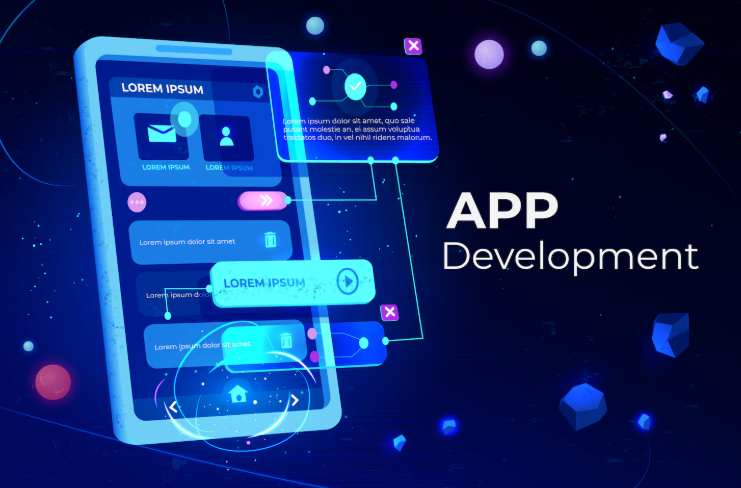Introduction
In today’s mobile-first world, businesses can’t afford to choose between iOS and Android—they need apps that run smoothly on both platforms. That’s where cross-platform app development comes in. By using frameworks like Flutter, React Native, and Xamarin, developers can build apps with a single codebase while delivering native-like performance.
As we move into 2025, cross-platform development isn’t just about saving time and costs anymore. It’s evolving with AI integration, cloud-powered tools, immersive technologies, and enhanced security. In this blog, we’ll explore the top cross-platform app development trends in 2025 that every business and developer should watch.
Why Cross-Platform Development Matters in 2025

Before diving into trends, let’s quickly recap why cross-platform development continues to dominate:
- Cost-efficiency – One codebase reduces development and maintenance costs.
- Faster time-to-market – Businesses can launch apps on multiple platforms simultaneously.
- Wider reach – Target both iOS and Android users without doubling efforts.
- Consistent UX/UI – Ensures brand consistency across devices.
- Scalability – Easier updates and feature rollouts across platforms.
With global app competition at an all-time high, cross-platform strategies in 2025 are shifting toward innovation, speed, and seamless performance.
Top Cross-Platform App Development Trends in 2025
1. AI-Powered Development Tools
Artificial Intelligence (AI) is reshaping how developers build apps. In 2025, cross-platform frameworks are integrating AI-powered coding assistants to auto-generate components, detect bugs, and optimize code for better performance.
- AI-driven testing will speed up QA cycles.
- Chatbots and voice assistants will be seamlessly embedded across platforms.
- Predictive analytics will help apps personalize user experiences in real time.
2. Flutter and React Native Domination
While multiple frameworks exist, Flutter (by Google) and React Native (by Meta) continue to dominate the cross-platform development space in 2025.
- Flutter 4.0+ now supports enhanced 3D rendering, making it ideal for gaming and AR/VR apps.
- React Native’s new architecture offers improved performance with multi-threaded rendering.
- Both frameworks provide near-native performance and wide community support.
3. Cloud-Integrated Cross-Platform Apps
With hybrid and multi-cloud adoption growing, cross-platform apps are increasingly cloud-native. In 2025:
- Apps will rely on serverless computing for scalability.
- Cloud-based APIs will make real-time sync and collaboration seamless.
- Developers will use cloud DevOps tools for continuous integration (CI/CD) across platforms.
This allows businesses to build lightweight, scalable apps without being tied to local device limitations.
4. IoT-Ready Cross-Platform Apps
The Internet of Things (IoT) is no longer limited to smart homes—industries like healthcare, logistics, and retail depend on IoT-enabled apps.
In 2025, cross-platform frameworks are expanding IoT SDKs and APIs, enabling apps to:
- Connect with wearables, smart appliances, and industrial sensors.
- Use voice activation and gesture controls for device management.
- Provide real-time insights for enterprise-grade IoT applications.
5. Immersive AR/VR Experiences
Cross-platform apps are stepping into the metaverse era. With Apple Vision Pro, Meta Quest, and other AR/VR headsets pushing the market, developers are prioritizing immersive app experiences.
- AR-enabled ecommerce apps allow users to “try before they buy.”
- VR-powered learning apps deliver realistic training simulations.
- Cross-platform compatibility ensures these experiences work seamlessly on multiple devices.
6. Enhanced Security with Blockchain & Zero-Trust Models
Cybersecurity remains a top concern in 2025, especially for finance, healthcare, and enterprise apps.
Cross-platform apps are adopting:
- Blockchain integration for secure payments and transparent data logs.
- Zero-trust security models requiring continuous verification.
- Voice and biometric authentication for frictionless logins.
7. Progressive Web Apps (PWAs) and Cross-Platform Convergence
PWAs are blending the gap between mobile and web applications. In 2025, many businesses are building hybrid apps that function both as PWAs and cross-platform apps.
Benefits include:
- Offline capabilities
- Instant updates without app store approvals
- Lower development costs compared to fully native apps
8. 5G and Edge Computing Enhancements
The global rollout of 5G networks and edge computing is revolutionizing mobile app performance.
- Ultra-low latency supports real-time interactions in gaming, healthcare, and IoT apps.
- Edge AI models process data locally, boosting speed and reducing reliance on central servers.
- Cross-platform apps can now handle high-definition video streaming and hyper-realistic graphics without performance bottlenecks.
9. No-Code and Low-Code Platforms for Cross-Platform Apps
By 2025, no-code and low-code platforms are empowering non-developers to build cross-platform apps faster.
- Small businesses can launch MVPs (Minimum Viable Products) quickly.
- Enterprises use low-code tools for internal apps and workflow automation.
- These platforms are now integrating with AI-driven app builders, making development even more accessible.
10. Focus on User-Centric Design and Accessibility
Cross-platform success in 2025 depends on UX consistency across devices. Developers are focusing on:
- Voice-first navigation for accessibility.
- Dark mode, dynamic themes, and adaptive layouts.
- Compliance with global accessibility standards (WCAG 3.0).
This ensures apps are not just functional but also inclusive and engaging.
Benefits of Adopting These Trends
For Businesses:
- Faster time-to-market and reduced costs.
- Wider user reach across multiple platforms.
- Competitive advantage with cutting-edge features.
For Users:
- Seamless, consistent experience across devices.
- Access to advanced AI, AR/VR, and IoT features.
- More secure, personalized, and reliable apps.
Challenges to Consider
While the future looks promising, businesses should prepare for:
- Performance issues compared to fully native apps.
- Framework compatibility with advanced device features.
- Ongoing costs of keeping up with rapid framework updates.
Working with experienced developers and leveraging the right frameworks can minimize these challenges.
Conclusion
As 2025 unfolds, cross-platform app development is no longer just about efficiency—it’s about delivering smarter, immersive, and more secure experiences across devices. From AI-powered assistants to AR/VR experiences, and from cloud-native apps to 5G-ready solutions, businesses that embrace these trends will stay ahead of the curve.
The future of mobile belongs to those who can combine speed, innovation, and accessibility—and cross-platform development is the key to making that happen.

